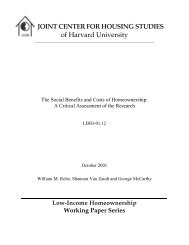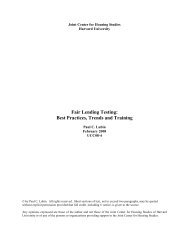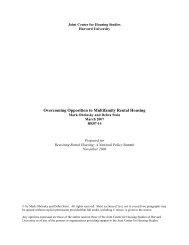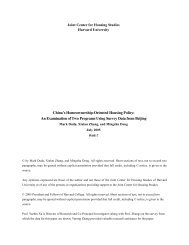Untitled - Joint Center for Housing Studies - Harvard University
Untitled - Joint Center for Housing Studies - Harvard University
Untitled - Joint Center for Housing Studies - Harvard University
Create successful ePaper yourself
Turn your PDF publications into a flip-book with our unique Google optimized e-Paper software.
Mortgage Models and Critical Variables<br />
In the course of building the first models, developers identified two key factors, loan-tovalue<br />
(LTV) and consumer credit scores as the most significant variables contributing to the<br />
predictiveness of the models. Of these variables the consumer credit score created the most<br />
controversy.<br />
The value of the consumer credit scores, developed by Fair Isaac’s and Company (FICO),<br />
and readily available from the primary credit repositories (Experian, Trans Union, and Equifax),<br />
has been recognized <strong>for</strong> more than a decade by consumer credit providers. Standard & Poor’s has<br />
reviewed consumer credit scores designed by Fair Issacs and provided as a FICO score by<br />
Experian, a BEACON Score by EquiFax and an IMPERICA score by Trans Union. These<br />
scores are used to measure the credit quality of individual borrowers. They incorporate the<br />
factors making up a borrower’s credit history across a broad spectrum of trade lines including<br />
credit cards, auto finance, mortgage payments and other consumer obligations. FICO scores, in<br />
other words, are an indication of borrower’s abilities to manage his or her finances.<br />
The scores have several advantages when used in the models that have been developed<br />
and implemented over the past several years. The most significant advantages are their<br />
availability and their consistency of calculation by the three major repositories. Unlike<br />
scorecards that are developed by individual lenders FICO scores can be acquired at the time of<br />
an application <strong>for</strong> both mortgage credit or any other consumer credit by all lenders who<br />
subscribe to the service. In addition, because the FICO score is a calculation encompassing all<br />
the trade lines associated with a particular borrower’s file the score has the advantage of being a<br />
leading indicator of mortgage per<strong>for</strong>mance. This is based on the rather intuitive behavior of<br />
individuals who are more inclined to begin to juggle their payments on their credit cards, their<br />
automobile payments, and other consumer payables be<strong>for</strong>e they begin to miss payments on their<br />
mortgages when they run into financial difficulties. This is particularly significant when one is<br />
reviewing portfolio per<strong>for</strong>mance on mortgages because trends in a borrower’s FICO score can be<br />
a harbinger of difficulties that might occur in the immediate future in their mortgage payment<br />
ability. This in<strong>for</strong>mation is useful not only in determining the future per<strong>for</strong>mance of a seasoned<br />
portfolio but it may also provide in<strong>for</strong>mation in improving the servicing response on a particular<br />
loan and the initiation of appropriate steps to work with borrowers to try and mitigate any<br />
7















